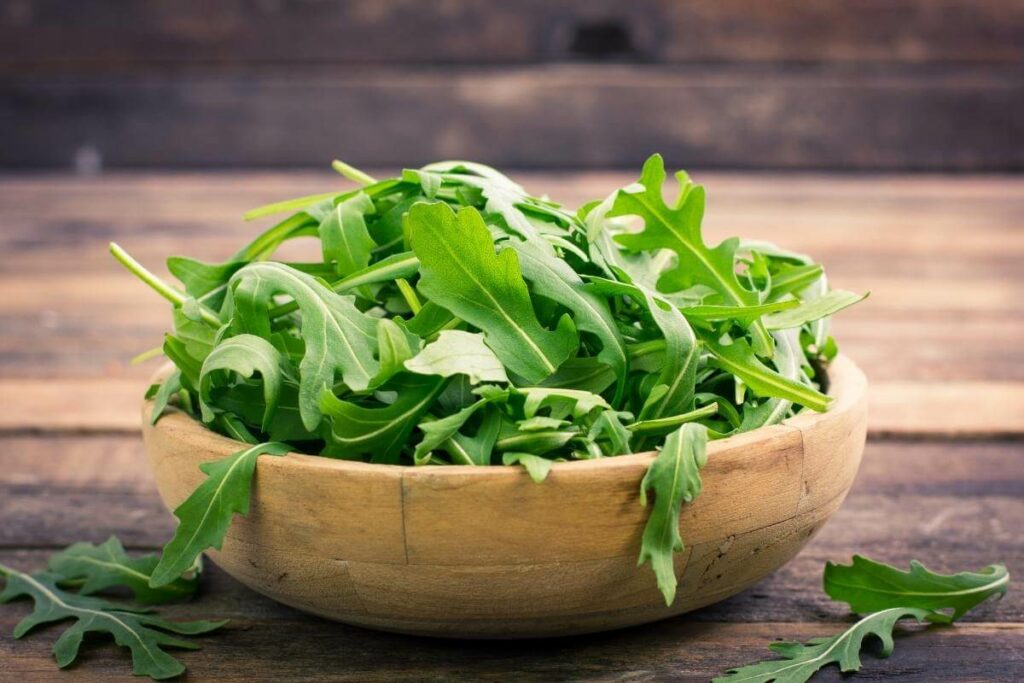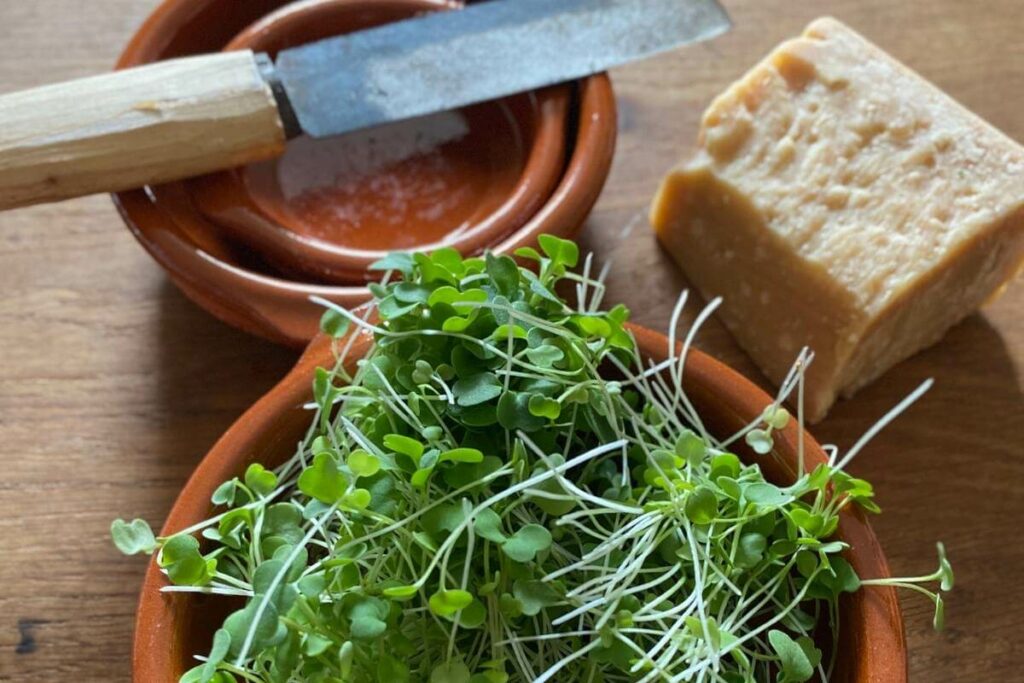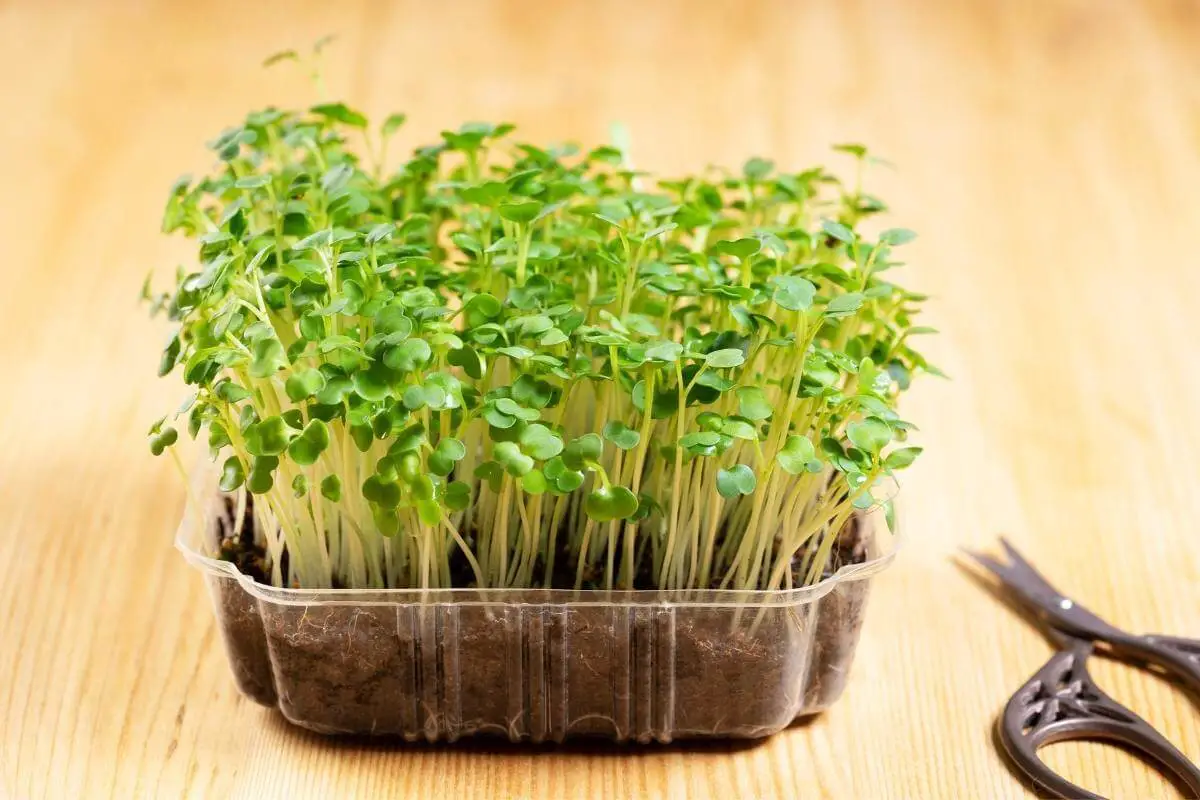Arugula microgreens and Arugula are the same plants that belong to the mustard and cabbage green families, but they are distinguished by the time of harvest. Arugula microgreens are picked considerably earlier than arugula and sold at a higher price.
When compared to Arugula, Arugula microgreens grow considerably quicker, are more nutritiously concentrated, healthier, have a superior taste, and are smaller in size.
They are both eaten fresh as salads and have a peppery flavor that goes well with other strong flavors such as bright citrus, salty cheeses, and others.
Try This: They are also used to top baked pizzas and to make pesto. They can also be sautéed for a mild side dish or mixed into soups, pasta, and other meals.
Arugula Microgreens Overview

Arugula microgreens are immature forms of Arugula that fall between a sprout and a mature Arugula.
They are little veggies that grow to be around five centimeters tall and have one open set of real leaves.
Therefore, they should not be confused with sprouts, which lack leaves.
They are quite simple and quick to cultivate and are consumed much sooner than ordinary arugula.
Despite their small size, Arugula microgreens are more nutritiously concentrated than mature Arugula vegetables.
As a result, they are an excellent complement to any diet.
Arugula Overview

Arugula is harvested when the plant is fully grown and has mellowed out in flavor and has become less nutritionally concentrated.
At this time the Arugula has flowered and its leaves develop a bitterness signature.
Arugula is not only delicious in salads, but it also works well in cooked meals like:
- all kinds of pasta and sautés,
- as well as a bed for seared, grilled, or meat and roasted fish.
It is somewhat less expensive than microgreens, but it takes longer to harvest and consume.
It also has health advantages and can help avoid diseases like cardiovascular disease, obesity, and cancer.
| Arugula | Arugula microgreens |
|---|---|
| Low amount of nutrients | High nutrients |
| Achieves maturity after 45-60 days | Achieves maturity after 7-14 days |
| Elongated leaves with ridges | Has delicate leaves that are curled into a heart shape, broad, smooth, flexible, flat with broad regular margins |
| Less pronounced peppery flavor with a trace of sweetness | More pronounced peppery flavor with a hint of sweetness |
| Has flowers | Doesn’t have flowers |
| Has fewer health benefits | Has more health benefits |
Nutritional Analysis and Health Properties
Time is a great enemy to nutrients in any plant.
Arugula microgreens contain up to nine times more nutrients than mature Arugula because they are harvested one to two weeks sooner than Arugula.
Arugula microgreens are considered healthier than full-sized Arugula because they contain disease-fighting chemicals and they are more costly than mature Arugula.
They are both high in calcium and vitamin K, which are beneficial to one’s health.
Calcium and vitamin K help to maintain healthy skin and bone growth.
However, when compared, Arugula microgreens have been proven to possess more significant quantities of essential minerals, vitamins, and beneficial Phyto-compounds to Arugula.
Time of Harvest
Arugula microgreens are picked between one and two weeks after sowing when they are tender.
They are around three inches tall and have one to two open leaves at this time.
On The Other Hand: Arugula will achieve maturity after 45–60 days and reach a height of 20–100 cm.
Form and Size

Arugula microgreens comprise of one to two tiny immature true leaves that are connected to a 5-centimeter-long thin stem.
These delicate green leaves are curled into a heart shape with broad, regular margins, and their surface is smooth, flexible, and flat.
These leaves contribute to the microgreen’s crisp, succulent, and delicate texture.
Arugula on the other hand has elongated leaves with ridges linked to slightly thicker stems and a length of around twenty to one hundred centimeters.
Their leaves are likewise somewhat crunchy in texture.
Taste
Most vegetables’ leaves retain their distinctive flavor throughout growth although the strength varies depending on growing circumstances and plant age.
You’ll Notice: Despite the fact that both Arugula and Arugula microgreens have a peppery flavor with a trace of sweetness, the microgreens are tastier since they are collected earlier than Arugula and have a more pronounced flavor.
Growth
Because Arugula microgreens are so delicate, they are usually cultivated inside greenhouses or other protective buildings in organic soil.
They also develop best under the appropriate temperatures, ventilation, and light, all of which need more attention and money.
While Arugula is mostly grown outside and prefers well-drained soil, it also prefers moisture.
How They Are Consumed

Both Arugula microgreens and Arugula are eaten without the roots and are commonly served fresh in salads.
The peppery flavor complements other intense flavors, such as salty cheeses, sharp citrus, and others.
They are also nutritious and are consumed as an add-on topping for pizzas, sandwiches, and nachos, making it into pesto.
They can also be sautéed for a mild side dish or mixed into soups, pasta, and other meals.
Final Thoughts
Although Arugula and Arugula microgreens are the same plants, they differ in terms of when they are picked, length, price, and nutritional content.
Arugula microgreens are significantly smaller than Arugula and can be sold or consumed before the Arugula.
They both come in handy when consumed since they can be taken at different times providing almost similar nutrients to the consumer.
These nutrients are beneficial as they help support the immune system, cell growth.
They also help maintain heart, kidney, and lung function and are also helpful to women who are pregnant or plan on becoming pregnant and reduce the chance of cancer.
You May Also Like
- 5 Microgreens That Regrow After Cutting
- How To Grow Cress in Cotton Wool
- How to Grow Chili Plants Faster at Home?
